The Bowls of Notre Dame
An architectural appraisal of the restoration and new furnishings at Notre Dame de Paris.
For the last five years, the world in general has been attentively watching Notre Dame de Paris, as it was restored from a devastating attic fire. With the reopening festivities now concluded, we can see more clearly what has been done.
Notre Dame is now the latest in a series of historical buildings, like the Frauenkirche in Dresden and, most similarly, Windsor Castle in 1992, to be restored after being ravaged by fire. Old buildings, whose secrets have been forgotten beneath generations of revisions, are uniquely vulnerable, not just to fire, but also their aftermath.
The Process
Even before the fire at Notre Dame had been fully extinguished, there was already a vow to finish the work by the Olympic Games, then five years away. Naturally, COVID interfered with this plan, but at least the flèche and most of the exterior had been restored by the Opening Ceremony, which - uniquely - was staged along the length of the River Seine. While this was seen as an audacious target, a similar goal was set for the restoration of Windsor Castle after the fire. The Frauenkirche, destroyed in an air raid and then abandoned for half a century, took around twelve years to rebuild - but it effectively had to be rebuilt from the ground up - incorporating fragments of the original building. To that end, it is perhaps most logical to compare the works at Windsor Castle and Notre Dame.
From the beginning, at both places, there were competing visions for what could be: a faithful, as-is restoration; a completely new vision; something in-between. Many a RIBA-touted paper architect of the Deconstructivist generation produced concepts for Windsor Castle which ranged from the impractical to the ludicrous; in like manner, many a contemporary paper architect came up with concepts which were largely too stupid to list, save only as prompts for an architectural drinking game. Certainly they failed to take into account the actual conditions on the ground, but I imagine they secured a great deal of publicity for these silly concepts; any publicity is good publicity, as our friends at MVRDV will doubtless remind us. But, of course, these are the same types that spent their lockdowns busily engaged in Coronagrifting and other forms of aesthetic ambulance chasing. Still, it is possible to excuse the plastic-rimmed portfolio-chasers; in my experience, they didn’t pay very close attention in the Architectural History courses, and wouldn’t have realized that the cathedral attic is basically an umbrella intended to keep the vaults from being damaged by weather.
Both Windsor Castle and Notre Dame were ultimately completed through a combination process. At Windsor Castle, the state rooms were largely restored to their pre-fire condition, in some cases redesigning textiles and passementerie that had been cheapened out over the years. Grand public spaces such as St. George’s Hall were treated more liberally, though still within the architectural language, and in many cases these treatments corrected pre-existing issues (the low ceiling in the old Hall was derogatorily compared to a railroad car on several occasions). At the same time, the back-of-house spaces wedged into the centuries-old castle were brought fully up to turn-of-the-Millennium standards, and some new discoveries (such as the surviving Medieval kitchen roof) and the Saint George’s Hall undercroft were finally given the opportunity to shine. Most remarkably, the tangled mess of staircases and passages into St. George’s Hall, and the awkwardly-shaped Private Chapel which had been burned to the walls, were torn out completely and replaced with a stunning new octagonal lobby. The cumulative effect is one of tremendous unity.
At Notre Dame, the decision was quickly made that the roof structure, vaults, stained glass, and other medieval (and Viollet-le-Duc) fabric that had been lost should be restored. This was possible due to comprehensive documentation of every square inch of the building, even research developed by a video game company. While other French cathedrals which suffered attic fires, such as Chartres in 1836, received contemporary roof trusses, “la forêt” would be restored as-is-where-is - wonky engineering and all. I was no great fan of this - why tempt fate again? - but I suppose that, with a modern fire suppression system now installed, it is as safe as can be.
Assessing the Space
The “new” Notre Dame is very bright. Extremely bright, in fact - far brighter than it would have been at any point in its history. In a cathedral of this size, in medieval times, it would have been common for the windows in the arcades to be “story” windows - using small pieces of vibrantly-colored glass to tell of different portions or themes from the Bible, while the clerestory windows, being quite hard to see from the ground, would have been glazed with “grisaille” glass, or with gigantic figures of saints or Christian heroes. Candlelight would have been the norm, casting a flickering amber glow from near the floor, where it would have played in the violet haze of the incense.
Purely due to the scale of the building, lavish decoration on the Nave vaulting would have been unlikely. David Macaulay, in Cathedral, gives his fictional Cathedrale de Chutreaux “red lines meant to even out the stonework on the high vaults.” Thus, those who believed that the ceiling should have been painted blue with gilded stars, a la the Sainte-Chapelle, were arguing more along the lines of the Victorian Gothicists, whether they realized it or not. Indeed, as before, the stone bosses and the tondo in the crossing vault have been painted and gilded, while the rest of the Lutéce limestone is left bare. Indeed, most of the decoration is to be found in the side chapels, where it can be seen, enjoyed, and well-illuminated by the adjacent windows.
In the nineteenth century, gas-jet chandeliers were introduced, which severely darkened the stone. Other French cathedrals were notorious for using coal braziers for heat; if this is what occurred here, then it is small wonder that, by the end of the 2000s, the interior of Notre Dame was seen as unforgivably gloomy. In fact, it had been darkened by several centuries of ash, smoke, and perspiration. To combat this, an extensive LED lighting system was installed in the early 2010s. This cast significantly more light within the darkened space, highlighting architectural details that had long since vanished into the greige void. The same lighting system appears to have been retained, or maybe strategically updated, post fire. Certain “reveal” videos from the Triforium level reveal banks of LED uplights, and, of course, the “Zillow lighting” was on full display in the reveal pictures posted this past week. Fortunately, this lighting system can be very finely controlled; the effect of the darkened vaults suddenly glowing with light at the start of Vespers is most exciting, if perhaps a bit theatrical. I should very much like to have such a finely-controlled lighting system in my home parish for the Great Vigil, Christmas Eve, and other such liturgies; however, I would prefer the triforium to be kept a bit darker, and for the grazing on the colonettes to be reduced.
Fortunately - or unfortunately - virtually all of the stained glass survived. The medieval glass, of course, is priceless, an assessment which cannot be made of the midcentury clerestory windows or some of the more syrupy Victorian glass in the side chapels. There are a great many windows which could rightly be replaced - those in the attics (destroyed by the fire, of course) and the tower rooms being prime candidates. Unfortunately, there has been a proposal to install new glass in the side chapels - even more unfortunately, the artist is primarily a painter. It may be time to call for an embargo on stained glass windows designed by painters; these are two completely different disciplines, handle light in two completely different ways, and have two completely different systems of composition. Excellence in one does not guarantee excellence in another.
Liturgical Furnishings
The new liturgical furnishings were designed by one Guillaume Bardet, a contemporary French designer who appears to work in bronze, ceramic, and marble, and the new vestments were designed by Jean-Charles, Marquis de Castelbajac,. I imagine that there was some expense to them. Certainly, having been “revealed” in just the past few weeks, they have incited quite a furor. Let us, therefore, review them category by category.
The Furnishings
The dominant furnishings are the font - erected at the west end of the Nave (for the first time in living memory) and the forealtar - erected as before on a crossing platform. Both suffer somewhat from design and scale issues; viewed from afar, they appear top-heavy and easily rocked. This is an unappealing characteristic for the furnishings upon which the dominical sacraments are celebrated - there should be a deliberateness, a solidity, and a gravity to these furnishings. I rather appreciate the evocation of waves in the polished cover of the font - but, as near as I can tell, covered fonts are somewhat of a contravention of the will of the Second Vatican Council.
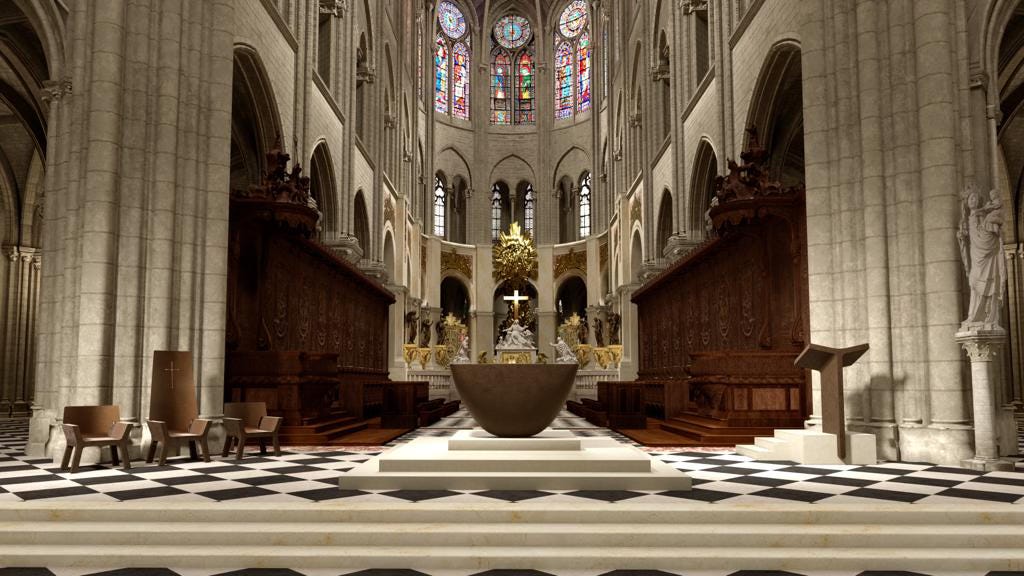
The altar is less successful. In general, Roman Catholic cathedral altars tend to be disappointments; pre-Solesmes, pre-conciliar ones are often out-of-scale; the first altar of St. Patrick’s, New York City was dwarfed by an overlarge reredos of the soda-fountain school of design; its replacement under Cardinal Spellman was a blessing. Post-conciliar altars, however, are even worse; removed from reredoses and often absent a baldacchino, they tend to look less like the venue where Heaven and Earth intersect, and more like an abandoned kitchen cabinet. Here, by changing the shape, we get the effect of “a boat,” or a giant cereal bowl, or an au courant vessel-style bathtub. And, as it is a small and dark object, it recedes even further into the lightened, airy space it has come to occupy.
Of the lectern and sedilia, little needs to be said; viewed from afar, these also have a degree of flimsiness and portability which is not entirely desirable for their function, and, while seating has been provided for the bishop and the three sacred ministers, given the present fad for “concelebration,” it appears that the choir will continue to sit in flimsy little chairs halfway up the quire, while the stalls are occupied with clergy. A particularly low point in the Mass for the Consecration of the Altar was when the Deacon of the Mass, for whom there was evidently no room at the new altar, had to scramble through a crowd of chasubled clerics to elevate the Precious Blood.
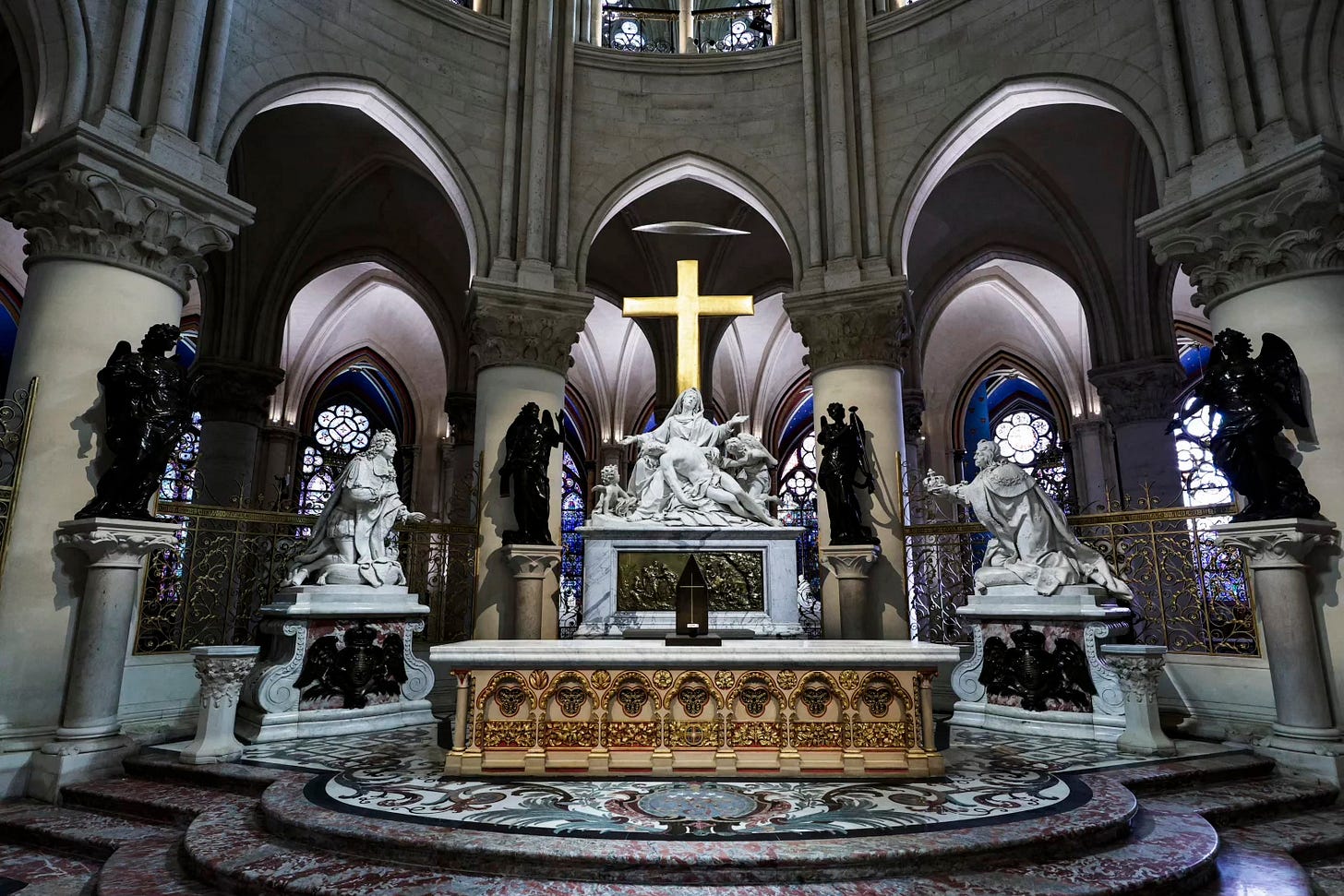
A new tabernacle has been placed atop the high altar, rendering it, I suppose, an “altar of reservation” and making its use for the Mass difficult, and its use for the usus antiquior Pontifical Mass (which envisions the tabernacle ‘vacated’ in advance) quite out-of-the-question. Presumably, visions of Lefebvrists occupy an unnecessary quantity of real estate in the minds of the occupants of the Episcopal Palace of Paris.
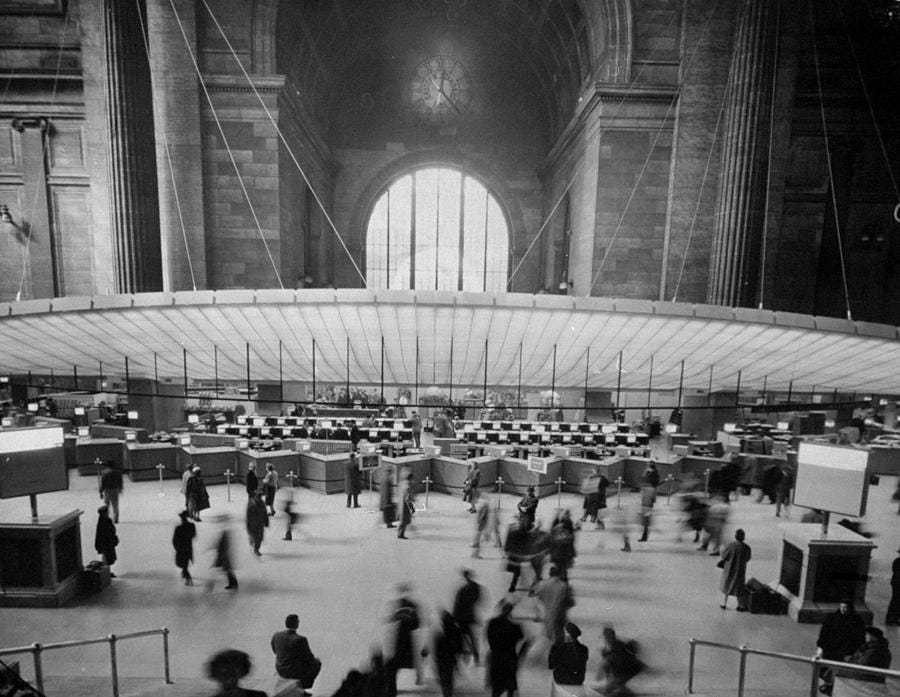
The cumulative effect of the new furnishings is close to that of the new ticket counter built in Penn Station in the 1950s - quite out-of-keeping with the space, but not audacious enough to do anything more than inject unwanted visual chatter. Thankfully, at least, Notre Dame enjoys far stronger protections than Old Penn did.
The Eucharistic Vessels
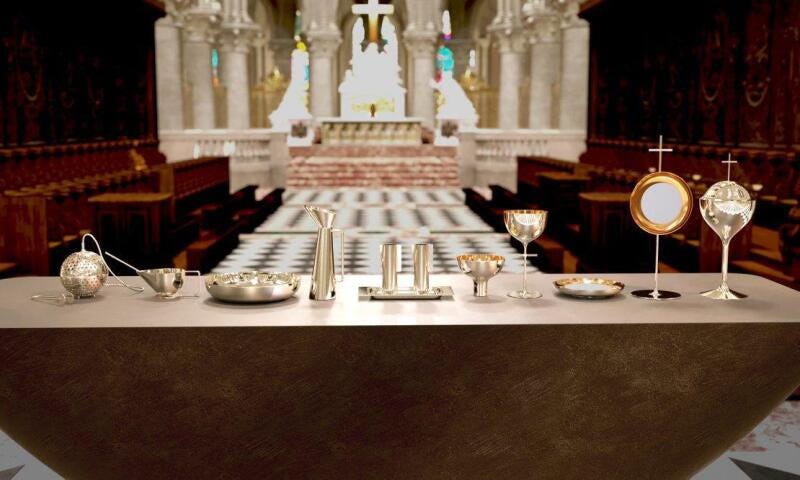
Monsieur Bardet has also designed the chalice, patens, ciboria, monstrance, cruets and tray, thurible and boat, and ewer and bason. Of note, these things are actually enormous - the altar and the forms render it quite difficult to reliably understand the scale. As a sometime subdeacon, I have had a degree of experience in handling most of these, so I will merely go through and critique them as follows:
Thurible: A softball-sized metal orb perforated with crosses, hung on a single strand of steel wire. The orb concept would be more intriguing if it wasn’t so evocative of a tea ball or not a moon. Incense goes in through the aperture on the upper hemisphere. Incense is inserted via the gaping maw where the superlaser should go, but there are plenty of thermal exhaust ports with which to expel smoke, ash, or bits of flaming charcoal.
Boat: Not bad, but a lid would be a help - depending on the variety of incense used, it may blow out otherwise.
Ewer and Bason: The dual-cone flagon/ewer isn’t a bad concept; in fact, I think I saw just such a thing in IKEA a few weeks back. But, as an acolyte, I should hate to have to use these for the lavabo; there’s no way to see how much water you’re pouring, and the bason is much too large. You could use this as a birdbath, but sparrows would drown in it; you could also use it for a baptism, but… why?
Cruets and Tray: Quite bad! The cruets, lacking a flared or weighted base, have a high center of gravity. Additionally, being opaque metal, it is impossible to see just how much wine is inside, so one risks tinkling it into the chalice or getting MUCH too heavy-handed. The tray appears to have sharp corners. If the Presentation of the Gifts occurs here, care should be taken that the person bringing the cruets forward doesn’t cut their hands or tip unconsecrated wine down their shirtfronts.
Footed Ciborium: Of a similar shape to the baptismal font, this is a failure in that it is difficult to hold, and even more difficult to hand off (there are several incidents of them nearly being dropped in the various tapes).
Chalice: Flimsy-looking, even though it’s actually gigantic, and the use of a cross in lieu of a knop makes it quite difficult to turn-and-wipe between ministrations of the Precious Blood. This is ergonomically stupid, and one runs the risk of being poked in the trachea.
Unfooted Paten: Evocative of a spaghetti bowl, but sufficient to hold a large quantity of Hosts.
Monstrance: Flimsy-looking, and quite evocative of a prop from Santa Claus Conquers the Martians.1 It is not at all clear to me how this monstrance is to be charged or vacated in an edifying way; the Precious Body appears to be suspended as though He had been Scotch-taped, or worse, impaled upon the luna.
Lidded Ciborium: Evocative of IKEA kitchenware, and with yet another flimsy cross on the top.
Now, I’m not opposed to modernity or minimalism in liturgical design, per se - the Matisse Chapel, for what it is, is brilliant. Here, however, where we’re designing for spaces that hold thousands of people and the reverb time is measured in multiple seconds, this rather falls flat. An object that does not relate meaningfully to the human scale when it is meant to be used is a nuisance (when it’s a fork that forces you to hold it in a funny way) or a menace (a saw with a grip that causes your hands to slip). The cumulative effect is of temporariness - that one has set up a card table and folding chairs in a grand ballroom for a microwaved diner a deux.
The Vestments
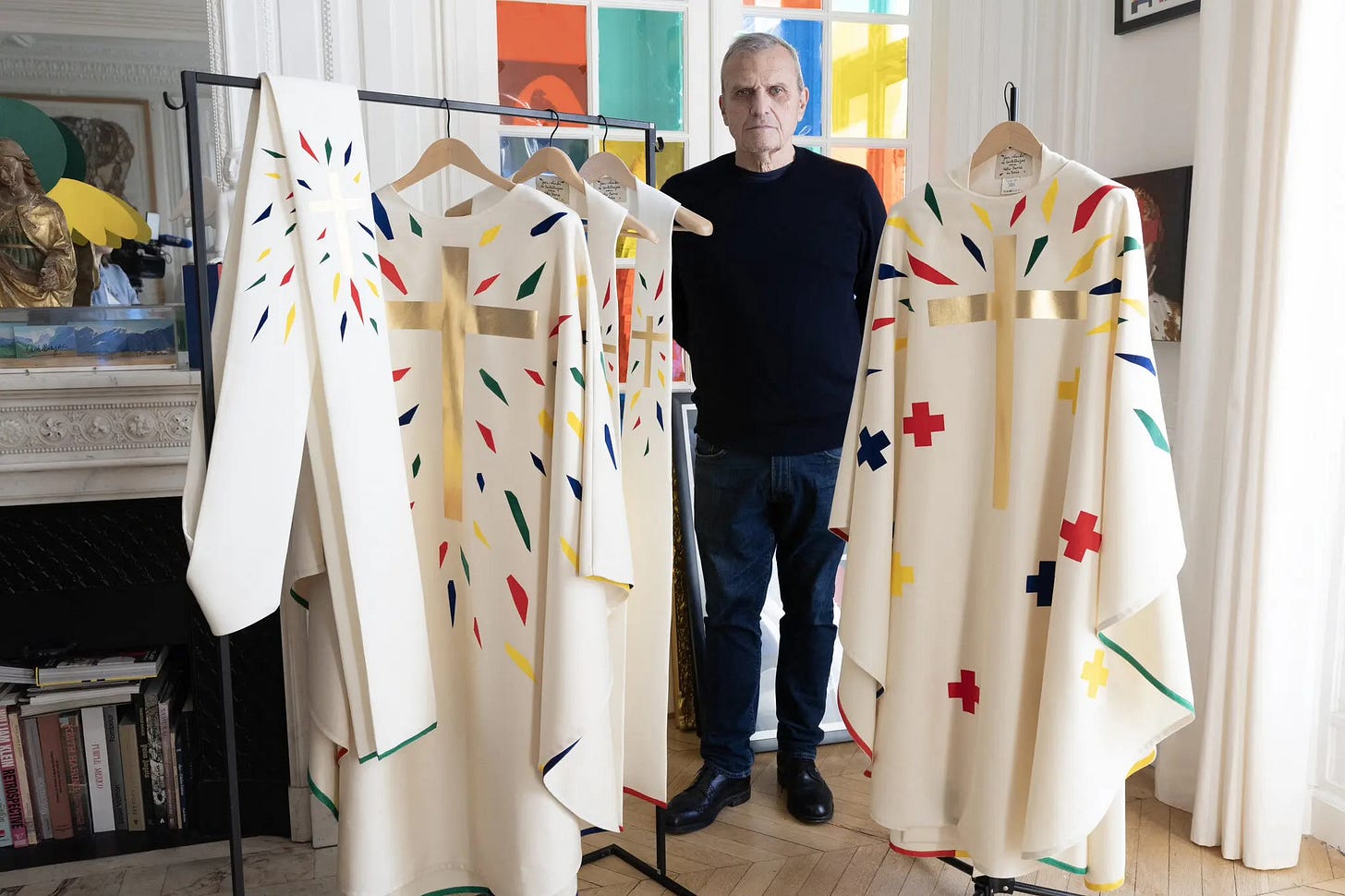
The new suite of vestments was designed by Jean-Charles, Marquis de Castelbajac, whose five-plus-decade career in the fashion industry has included such things as Madonna’s teddy bear jacket and the rainbow-colored vestments for World Youth Day 1997. The use of golden crosses is intended to evoke the Couturier cross erected behind the Pieta in 1997; the use of red, yellow, blue, and green “facets” and crosses is, evidently, an homage to his late collaborator, Keith Haring2 (!). It is said that these vestments are evocative “of the youth” “of the church of today,” but I’m not exactly certain that a septuagenarian member of the French aristocracy is in any position to speak about “the youth” of “the church of today,” unless one prefaces “children” with “flower.”
On a practical note, the vestments appear to be made of a flimsy, unlined fabric, so they will drape most unflatteringly over the be-cassalbed paunches3 of their wearers. (This seems to be a recurring problem with Roman Catholic vestments - witness how the coronation copes “generously lent” by Westminster Cathedral hung off of soon-to-be-former-Archbishop Welby’s shoulders.) While they should be easy to clean, the colored portions were apparently applied using a “sublimation” process used for making sweatshirts. Something needed to be sublimated, all right. Precisely what this means for maintenance and longevity is unclear. The concept, at least, is interesting, even if the ethics4 of the fashion industry lead me to regard the techniques used with more than a little suspicion. It is also worth noting that, on the sets now on display in the sacristy, a visiting friend has noted critically that the quality of the seaming is poor, with raised stitches and puckered fabric readily visible.
The Outlook
It is, perhaps, unfortunate that this catastrophe had to happen as the Church finds itself embroiled in a generational and theological power struggle. While we knew full well that we wouldn’t be removing the flouncing Baroque statuary from the chancel, much less reconstructing the ancient jubé or the medieval altar, there was a real opportunity here to show the world a face rather fresher than sixty-five years of internecine clerical squabbling, and a face ready to face the world after the end of history. Minimalist modernism is not bad - in fact, it’s far more honest than the sentimentalist stuccoed stage sets with which Roman Catholics of the Victorian era bespattered many an American town, and to which the traditionalists of today wish to “retvrn!” Paris already has a neighborhood for that sort of thing.
However, when injected into a space which overpowers it this thoroughly, high minimalism is at best underwhelming, and at worst a sort of aesthetic onanism5 on the part of the designers. No real effort has been made to tie the new furnishings into what-already-is, and, faced with the glorious rose windows, the majestic Cavaillé-Coll organ, the treasury of relics, and the millions of prayers raised over hundreds of years, these poor fittings will find themselves quite underprepared for the task at hand. “Cistercian[-inspired]” has been the aesthetic du jour for several decades, now - and while it makes sense in that context, it falls rather flat here.
The good news, I suppose, is that there’s no guarantee that these fittings will remain in use for a very long time. All episcopates have their end, and there’s plenty more room in the treasure-house of the Cathedral of Notre-Dame. Let us, for now, pray that the heroic architectural effort of the past five years stands as a delight and inspiration for centuries to come.
You thought I was making this up?
It is worth noting that Haring did, in fact, design an altarpiece which is now displayed in an even larger cathedral than Notre Dame. However, it is displayed in a side chapel at St. John the Divine, and works well there because it is not overwhelmed by the space.
The cassalb, of course, is a stooge garment; usually made out of plastic-based fibers, it lacks sufficient fabric to drape well, and tends to be more transparent than its wearer thinks. Additionally, if one does not have the physique of an Olympian swimmer, it is best to tie the cincture across one’s stomach, and not below it.
Or lack thereof.
See also: certain proposals for replacement spires.




